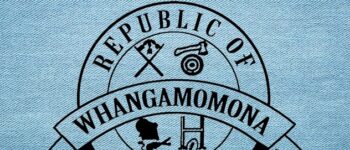1989: The Republic of Whangamomona
January 30, 2023
By AHNZ

Whangamomona, Taranaki.
First settled in 1895, the name means ‘Fertile Valley’. These people were Taranaki settlers and they sent their young men to die in two world wars as Taranaki men. The Alexander Turnbull library has a photo of a World War 1 trench, probably at Gallipoli, named after the home of the Whangamomona ANZAC soldiers (see image below.)
In 1989 The State determined they would not be Taranaki people any more but instead be a little holding of the Manawatu-Wanganui fiefdom. This did not go down well!
Local government all over New Zealand was being cut down by the scythe of Brian Elwood, Chair of the Local Government Comission and powered by Local Government Minister Michael Bassett of Labour 4.0.
“On 1 November, 1989, 817 Local Governments were cut down by Labour 4.0 into just 86. Larger regional councils ate up the old counties and boroughs and even some city councils. Big War Lords took over the little ones.” – 1989: The Great Amalgamation, AHNZ
“In previous years, people had to buy a passport to enter the town for Republic Day, at the small cost of $5. On Saturday, post Covid, it was decided that the passports would be optional for the day, but around 700 to 800 were still sold, Haskell said.” – Whangamomona celebrates in style, showing it’s a town like no other, Taranaki Daily News (2023)
“The Local Government reforms were a dramatic change to New Zealand culture carried out, as we have seen, in a secret meeting so as to short-circuit the consent process if not the legal one.
“Central Government, thus, has expanded its powers while appearing not to do so. An entire part of our democratic checks and balances has been relegated to the dirty-job of being the customer-facing people-wrangling job which leaves the rulers free to focus on true power. Local Government is left with crumbs of power and money which is why few quality people stand for election and fewer still are elected. In return for this minor power transfer the local politician, a shadow of their pre-revolution namesakes, are the customer-facing part of government.” – 1989: Brian’s Revolution, AHNZ
“Though the move began as a pointed protest, the town continued to hold a celebratory Republic Day once a year, during which a vote for President was held. The day has become a local festival day, and attracts visitors from throughout the North Island. In 2001, the celebration became biennial, held in January to take advantage of the summer weather.” – Wiki
“…Whangamomona was to be ripped out of the heart of Taranaki to come under the Manawatu-Wanganui regional council. And the good people of Whangamomona weren’t happy. So, as the men drank, an idea was born: they would declare Whangamomona independent. A poem was written for the occasion: Stuff the Manawatu. At early Republic Day celebrations, the crowd collectively booed Manawatu. The ritual has been dropped over the years” – Lost in time, Taranaki Daily News (2009)
New Zealanders in huge numbers howled as their country was transformed without their consent. Old, traditional, locally controlled institutions were amalgamated and destroyed all over the map. In particular it was a changing of the guard from the post-War New Zealander to the new Baby Boomer generation who lacked attachment to home soil or what the Maoris call ‘mana whenua.’
The 1989 coup of local government is a fascinating subject to the Anarchist historian. Those who cared are passing away and their hurt and outrage un-reported in mainstream history. Why would it be part of the story? The victor write the history books so according to State history there was nothing to see here. No revolution. No great power transfer. No quiet genocide of scores of little Kiwi communities disenfranchised at a stroke of the pen.
Yet, a different and enduring response to the Great Amalgamation occurred in Whangamomona. The old pre-Boomer ethos of individualism and autonomy refused to be relegated to compelled speech and assigned identity directed from Wellington.
Thus, on 1 November 1989, The Republic of Whangamomona was declared. It’s not legal. It’s not enforceable. But, Whangamomona is a Republic within New Zealand and have held their ground now for over 30 years. It’s very much a case of not being a failure until you accept defeat. Elwood and Bassett could take away earthly power but had no say in Whangamomona spirit.
Apparently this Whangamomona Republican spirit was a devout local conviction in the first years of the secession. In more recent years it has descended into self-mockery. Presidential elections are conducted in a toilet and sometimes the office has been held by a goat or a dog. Rather than keep to the November anniversary the Republic Day was moved to sunny January. In 2023, rather than be independently self-financing, Whangamomona accepted money from The State. It seems New Plymouth District Council has condescended to the Republic and made it into a puppet after all. A side-show attraction to help lure tourist revenue to the Forgotten Highway. It is hoped not.
The State can pigeon-hole as it pleases but that never means a community has to consent to surrendering their cultural identity. This expression of autonomous identity is refreshed biennially with festivities and excellent Republic merchandise. The future Republic Days are to be on odd-years, eg. 2025,2027,…
—
Image ref. Whangamomona Republic logo, Stratford Disctrict Council (2023,) Colour by AHNZ (2023)
Image ref. World War 1 trench named Whangamomona, Austen Album, Alexander Turnbull Library
Ref. One dollar Whangamomona currency, 1993. New Plymouth District Council
Ref. Whangamomona Republic, Facebook
Note: Observing a Whangamomona cap at Puhoi Hotel first tipped AHNZ off to the Republic.
 Like Comment Share
Like Comment Share






